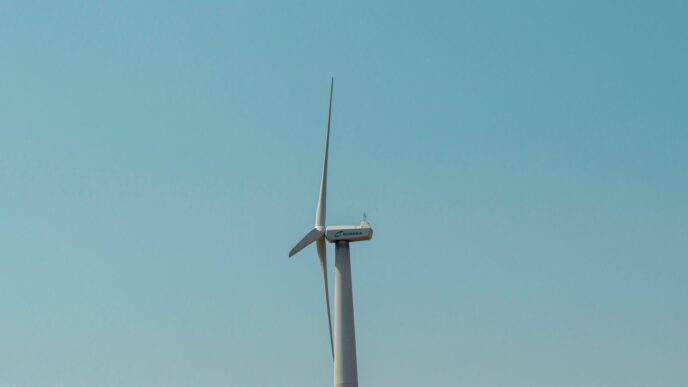Thinking about going solar in California but don’t own your home or have the right roof? You’re not alone. Many Californians face these exact issues. Luckily, there’s a growing solution called california community solar. It’s a way for regular folks, renters, and even businesses to get the benefits of solar power without putting panels on their own property. Let’s break down what it is and how you can get involved.
Key Takeaways
- California community solar lets you subscribe to a local solar farm and get credits on your electric bill, saving you money without installing panels.
- It’s a great option for renters, homeowners with unsuitable roofs, and businesses looking to cut energy costs.
- While California has been slower to adopt community solar compared to other states, new policies are paving the way for wider access.
- Savings typically range from 5-10% off your annual electricity costs, depending on the specific program.
- Signing up is usually straightforward, often involving comparing projects online and submitting basic information.
Understanding California Community Solar

California has been a leader in clean energy for a while now, but when it comes to community solar, it’s been a bit of a late bloomer. For years, various programs tried to get things going, but they didn’t quite hit the mark, with only about 160 megawatts (MW) online after several years. These earlier attempts had issues like limiting who could join, unpredictable costs, and not enough resources. But things are changing.
What Is Community Solar?
Think of community solar as a way for a whole neighborhood or town to share the benefits of a solar farm. Instead of putting panels on your own roof, you subscribe to a portion of a larger solar project nearby. This means you get credit on your electricity bill for the clean energy produced, even if you can’t install solar yourself. It’s a way to support renewable energy and save money without needing to own a home or have a sunny roof.
How California Is Embracing Community Solar
California passed a law called AB 2316 in 2022, which is a big deal for community solar. This law gives the California Public Utility Commission (CPUC) a clear path to create a program that works for everyone and helps keep the grid reliable. A key part of this is making sure low-income households can participate, requiring at least 51% of participants to be from these communities, which is higher than in most other states. The CPUC is looking at a plan called the Net Value Billing Tariff (NVBT), which is similar to a system used in New York. This plan also suggests that solar projects should include battery storage, which can help by releasing energy during peak times, like in the evening during hot summer months.
Key Benefits Of Community Solar
Community solar offers a bunch of advantages, especially for people who can’t put panels on their own homes:
- Cost Savings: You can typically expect to save about 5-10% on your annual electricity costs. Some business owners might see even higher savings.
- Accessibility: You don’t need to own your home or have a suitable roof. If you have an electricity bill, you can likely participate.
- Environmental Impact: You’re directly supporting the growth of clean, renewable energy in your local area.
- Ease of Use: Signing up is usually straightforward, and you don’t have to worry about installing or maintaining any equipment yourself.
Who Can Benefit From Community Solar?
You might be wondering if community solar is something that works for you, especially if you’ve thought about solar panels before but ran into roadblocks. The great news is that community solar is designed to be way more inclusive than traditional rooftop solar. It opens the door for a lot of people who previously couldn’t go solar.
Renters And Community Solar
If you rent your home, putting solar panels on the roof is usually a non-starter. You can’t make permanent changes to a property you don’t own, and landlords often aren’t keen on the idea anyway. Community solar is a game-changer here. You can subscribe to a share of a local solar farm and get the benefits, like lower electricity bills, without needing to own a home or get permission for installations. It’s a way for renters to directly participate in clean energy and save money.
Homeowners And Community Solar
Even if you own your home, community solar can still be a fantastic option. Maybe your roof isn’t ideal for solar panels – perhaps it’s shaded by trees, faces the wrong direction, or is simply too old. Or maybe the upfront cost of installing a rooftop system feels too high right now. Community solar lets you get the advantages of solar energy without needing a perfect roof or a big initial investment. You’re essentially buying into a larger solar project elsewhere in the community and getting credits on your utility bill for the power it generates.
Business Owners And Community Solar
Businesses, from small shops to larger operations, can also tap into community solar. Like homeowners, businesses might have unsuitable roofs or face significant installation costs. Community solar offers a way to reduce operating expenses by lowering electricity bills and to meet sustainability goals by supporting renewable energy. It’s a practical way to go green and save money without the hassle of installing and maintaining your own solar array.
Navigating Community Solar Savings And Programs
Estimated Savings With Community Solar
So, how much money can you actually save with community solar? It’s not a one-size-fits-all answer, but generally, you can expect to see a reduction on your electricity bill. Think of it like this: you’re buying a share of a solar farm, and the energy that share produces gets credited back to your utility account. These credits usually show up as a discount on your monthly bill. The exact amount saved depends on a few things, like the specific project’s pricing, how much energy it generates, and your own electricity usage. Some programs might offer savings of 10-20% off your usual electricity costs, but it’s always best to check the details of the project you’re considering.
Understanding Virtual Net Metering
This is a big one for community solar. Virtual Net Metering, or VNM, is the system that makes community solar work for people who don’t have solar panels on their own roof. Basically, the solar farm is connected to the grid, and the electricity it produces is sent out to the grid. Your utility company then tracks how much energy your share of the solar farm produced. Instead of getting a direct bill credit for energy sent back to your own home (like you would with rooftop solar), VNM allows you to get credits on your utility bill for the energy produced by the shared solar project, even if it’s miles away. It’s a clever way to distribute the benefits of solar energy across a wider area and to more people.
California’s Evolving Community Solar Landscape
California is really getting into community solar, and the rules and programs are still developing. The state is working to make solar energy more accessible, especially for folks who can’t put panels on their own homes, like renters or people living in apartments. There are different types of programs popping up, and the state is figuring out the best ways to make sure these programs are fair and beneficial for everyone involved. This includes making sure the savings are real and that the programs are easy to understand and join. It’s a dynamic area, so staying informed about new policies and program updates is a good idea as California continues to expand its community solar offerings.
Choosing And Signing Up For Community Solar
So, you’re thinking about jumping into community solar. That’s awesome! It’s a really smart way to get in on solar energy without needing your own roof. But, like anything, there are a few things to figure out before you commit. Let’s break down how to pick the right project and get signed up.
How To Choose The Right Community Solar Project
This is where you want to do a little homework. It’s not just about finding any project, but the best one for you. Think of it like picking a phone plan – you want one that fits your needs and budget.
Here are some key things to look at:
- Estimated Savings: Everyone wants to save money, right? Look at what kind of discount you can expect off your usual electricity bill. This can vary, so compare a few options. Most people see a discount between 5-10% annually.
- Contract Terms: What are you signing up for? Read the fine print. Pay attention to how long you’re committed, what happens if you move, and if there are any cancellation fees. Some projects might have a small sign-up fee, while others are $0 down.
- Project Location and Details: Where is the solar farm? While you don’t need to be right next door, knowing the general area can be helpful. Also, check out the project’s launch date – you’ll start getting credits once it’s up and running.
- Billing Structure: How will this work with your current utility bill? You’ll usually get two bills: one from your utility (with credits applied) and one from the community solar provider for your subscription. Make sure you understand how this all shakes out.
The Simple Process Of Signing Up
Honestly, signing up is usually pretty straightforward. It’s not like trying to assemble IKEA furniture, I promise.
Here’s a general idea of what to expect:
- Find Projects Near You: You’ll typically start by entering your zip code to see what community solar projects are available in your area.
- Review Project Details: Once you see a list, click on the ones that interest you. This is where you’ll find all that important info we just talked about – savings, contract terms, and so on.
- Get Started: Found one you like? There will be a button or link to begin the subscription process. You’ll need to provide some basic information, like your name, address, and your utility account number.
- Finalize Your Subscription: The project developer will usually reach out to confirm everything, go over the contract one last time, and make sure you’re all set.
- Start Saving: After the project is live (they’ll tell you when!), you’ll start seeing those credits on your utility bill and saving money. It usually takes about a month or two after the project launches for this to kick in.
Finding Community Solar Developers
Okay, so where do you actually find these projects and developers? It can feel a bit like a treasure hunt, but there are ways to make it easier.
- Online Marketplaces: Websites like EnergySage have a community solar marketplace. These platforms let you compare different projects side-by-side, which is super handy. They often list details about savings, contract terms, and the developers involved.
- Utility Company Information: Sometimes, your local utility company might have information on their website about community solar programs or developers operating in their service area. It’s worth a look.
- Local Government Resources: Your city or county might also have resources or links related to clean energy initiatives, which could point you toward local community solar options.
Right now, there are a couple of developers active in California with projects available. Keep an eye out for names like Ampion Energy and PowerMarket, but remember that more can pop up as the market grows.
Community Solar Versus Rooftop Solar
So, you’re thinking about going solar in California, which is awesome! But you’ve probably heard about two main ways to do it: rooftop solar and community solar. They both get you clean energy, but they’re pretty different, and one might be a much better fit for you than the other. Let’s break it down.
Key Differences Explained
Rooftop solar is what most people picture when they think of solar power. You get panels installed right on your house’s roof. It’s great if you own your home and your roof is in good shape and gets plenty of sun. Community solar, on the other hand, is like a shared solar farm. You subscribe to a portion of a larger solar project located somewhere else in your community. You don’t need your own roof space, which is a big deal for a lot of people.
Here’s a quick look at how they stack up:
| Feature | Rooftop Solar | Community Solar |
|---|---|---|
| Upfront Cost | Usually requires a significant initial investment | Typically no upfront cost |
| Savings | Offers the highest potential long-term savings | Generally provides lower, but still significant, savings |
| Eligibility | Homeowners only; requires suitable roof space | Renters and homeowners; no roof needed |
| Maintenance | Your responsibility | Handled by the project developer |
| Incentives | Eligible for federal and state tax credits | Usually not eligible for most solar incentives |
| Property Value | Can increase your home’s value | No direct impact on property value |
When Community Solar Is The Better Option
Honestly, community solar is a game-changer for a lot of Californians who thought solar was out of reach. If you rent your home, community solar is likely your only realistic path to using solar energy. You get the benefits of clean energy and lower electricity bills without needing permission from a landlord or worrying about installing anything on a property you don’t own.
Even if you own your home, community solar can still be a fantastic choice. Maybe your roof isn’t ideal for panels – perhaps it’s shaded, too old, or has a weird shape. Or maybe you like the idea of solar but aren’t ready to shell out a big chunk of cash upfront, even with financing options. Community solar lets you skip that large initial expense and the hassle of system maintenance. You just sign up, and you start getting credits on your electricity bill for the clean energy you’re now a part of. It’s a simpler, more accessible way to go green and save some money.
Wrapping Up Your Community Solar Journey
So, that’s the lowdown on community solar in California. It’s a pretty neat way to get in on solar energy, even if you can’t put panels on your own roof. Whether you rent your place, have a roof that’s not quite right for solar, or just want to save a bit on your electricity bill, community solar seems like a solid choice. California’s been a bit slow to get this going compared to other places, but things are picking up, especially with new rules in place. It’s definitely worth looking into if you want to support clean energy and maybe put a little extra cash back in your pocket each month. Give it a look, compare your options, and see if it’s the right fit for you.














